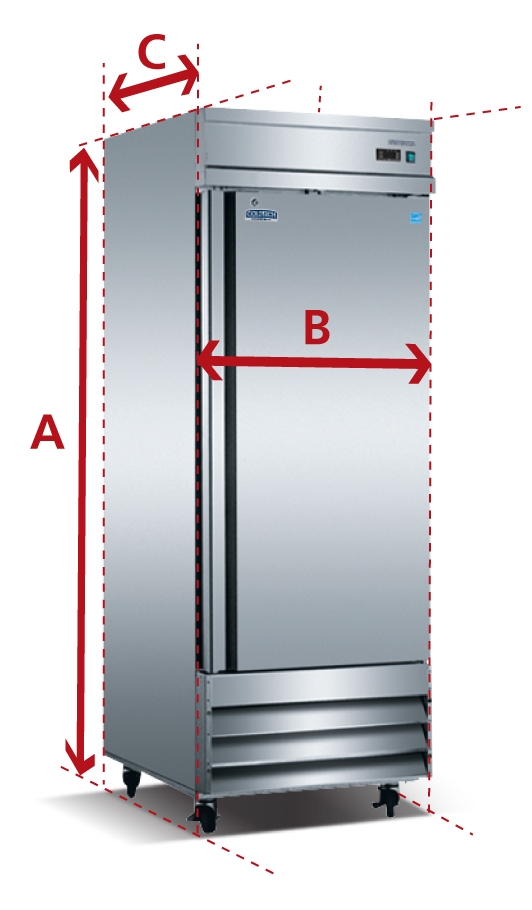How Many Watts Does a Refrigerator Use Per Day? (Explained!)
Refrigerators are known to be significant consumers of electricity in households. The question arises: how many watts does a refrigerator use per day?

Typically, conventional refrigerators have a starting wattage rating ranging from 200 to 800 watts. However, during regular operation, they require a running wattage of 70 to 280 watts per day. It’s worth noting that larger-capacity refrigerators may require higher wattage for both starting and running.
It’s important to understand that power usage is influenced by various factors. These factors include the size of the refrigerator, its type, energy-star rating, usage patterns, location, age, working condition, and the set temperature.
Before delving into the factors affecting power usage, it’s essential to learn how to calculate your own refrigerator’s power consumption. This knowledge is crucial if you want to assess the impact of your appliance on your electricity bill.
How to Calculate Refrigerator Power Consumption
Did you know that you can calculate the amount of electricity your refrigerator uses on a daily basis? It’s true! There are several methods you can use to determine your fridge’s power consumption:
Energy Star Rating
Using the Energy Star label, you can follow these steps to determine your refrigerator’s power consumption:
- Identify the estimated yearly electricity consumption in kilowatt-hours (KWh) on the Energy Star label.
- Divide the value by 1000 to convert it to watt-hours per year.
- Divide the watt-hours per year by 365 to get the watt-hours per day, which represents the energy consumption.
- For example, if the Energy Star rating indicates a yearly consumption of 227 KWh, the daily energy consumption would be approximately 622 watt-hours. To get the average daily consumption in watts, divide the watt-hours per day by 24, resulting in 25.91 watts.
Fridge Wattage Formula
Even if your refrigerator doesn’t have an Energy Star rating, you can still calculate its power consumption using its wattage rating. There are three approaches you can take:
- Option 1: Duty Cycle Formula: Multiply the fridge wattage (as stated on the label) by the duty cycle percentage. For example, if the fridge wattage is 500 watts and the duty cycle is 35%, the actual consumption would be 500 x 35% = 175 watts. If the fridge runs for 8 hours a day, the average daily consumption would be 175 watts.
- Option 2: Energy Consumption in kWh: Divide the fridge’s wattage by 3 to get the actual energy consumption. Then divide by 1000 to convert it to kilowatt-hours (KWh). Multiply the KWh value by 24 to get the daily consumption. For example, if the fridge wattage is 500 watts, dividing by 3 gives 167 watts. Dividing by 1000 results in 0.167 KWh per hour. Multiplying by 24 gives a daily consumption of approximately 4 KWh.
- Option 3: Multiplying by the Number of Running Hours: If you know the number of hours your fridge runs per day (e.g., 8 hours), you can simply multiply the fridge wattage by the running hours. For example, if the fridge wattage is 500 watts, multiplying by 8 gives 4000 watt-hours. Dividing by 1000 converts it to kilowatt-hours, resulting in 4 KWh, which is the daily power consumption.
Power Meter
You can use a power meter to directly measure your fridge’s power usage throughout the day. These meters can monitor variables such as continuity, voltage, and ampere. Simply plug the meter into the fridge and observe the power consumption.
Amperage Formula
If you know the amperage of your refrigerator and the voltage of the power supply, you can calculate the fridge’s wattage by multiplying the amperage by the voltage.
Energy Calculator
Websites like Energyusecalculator.com allow you to input your fridge’s wattage and estimate its electricity usage and cost. This can be a convenient way to determine your refrigerator’s power consumption.
By considering factors such as the starting and running power, fridge size, type, energy-star rating, season, usage patterns, location, age, and set temperature, you can get a more accurate estimate of your refrigerator’s power consumption.
Refrigerator Power Consumption: Understanding Wattage and Cost
Determining the daily wattage usage of a refrigerator requires multiplying the wattage rating by the duty cycle percentage, typically around 35%. To provide a baseline, here are the average wattage values for different fridges based on their labeled running wattage:
| Fridge Wattage Rating (on the Sticker) | Actual Consumption (after factoring in the 35% Duty Cycle) |
| 100 watts | 35 watts |
| 200 watts | 70 watts |
| 300 watts | 105 watts |
| 350 watts | 122.5 watts |
| 400 watts | 140 watts |
| 500 watts | 175 watts |
| 600 watts | 210 watts |
| 700 watts | 245 watts |
| 800 watts | 280 watts |
| 1000 watts | 350 watts |
| 1500 watts | 525 watts |
| 1800 watts | 630 watts |
To estimate the monthly wattage usage, conventional refrigerators typically consume 300 to 800 watts. On average, this translates to a monthly cost of around $20. However, larger fridges with a capacity of 240 to 300 liters may require more wattage, exceeding 150 watts.
Several factors influence a refrigerator’s power consumption per day:
- Starting vs. running power: Conventional fridges utilize 70 to 280 watts for running power but require a higher starting wattage of 200 to 800 watts.
- Fridge size: Generally, larger fridge capacities result in higher power consumption. Compact and under-the-cabinet fridges tend to consume less energy.
- Fridge type: Commercial refrigerators consume more power compared to residential models. Side-by-side and French-door fridges also utilize more energy than single-door options.
- Energy Star rating: Energy Star-rated fridges may consume more electricity than non-rated alternatives. When purchasing a refrigerator, it’s advisable to check the label to avoid excessive power usage.
- Season: Refrigerators typically consume more energy during the summer as they work harder to maintain cooling temperatures.
- Usage/stocking: Frequent opening of the fridge door leads to heat loss and increased power consumption. An understocked fridge also utilizes more energy compared to a reasonably stocked one.
- Location: Placing a refrigerator in a warm environment forces it to work harder, resulting in higher power usage. Cooler locations minimize energy consumption.
- Age of the fridge: A well-maintained refrigerator consumes less energy, while a malfunctioning or dirty unit may exhibit increased energy consumption.
- Set temperature: Using the factory temperature settings typically results in lower energy consumption compared to adjusting the temperature manually.
Tips to Reduce Refrigerator Power Consumption:
Implementing these strategies can help lower your electricity bill:
- Keep the fridge away from heat sources such as cookers, heaters, computers, and direct sunlight.
- Minimize the duration the fridge door remains open to prevent excessive heat loss.
- Set the refrigerator temperature to optimal levels (around 37°F) and the freezer temperature to approximately 0°F.
- Regularly clean the fridge, especially the condenser coils, to ensure efficient cooling and reduced power usage.
- Allow hot food to cool before placing it in the refrigerator to prevent the unit from overworking.
- Replace worn-out door gaskets to prevent cold air leakage and optimize energy consumption.
- Consider purchasing energy-star-rated refrigerators that offer improved energy efficiency.
- Ensure adequate clearance around the refrigerator for proper ventilation, which can lead to lower energy consumption.
- Upgrade to energy-efficient LED lights in the refrigerator for reduced power usage.
Common Inquiries
How much electricity does a refrigerator use?
The average refrigerator typically has a wattage rating between 300 and 800 watts, although it often operates on lower wattage. Power consumption primarily depends on factors such as running duration, type, size, age, and usage. Other significant considerations include energy-star rating, temperature settings, season, and location.
What is the monthly electricity usage of a refrigerator?
The following table presents the expected electricity usage per month based on the refrigerator’s wattage rating. On average, running a conventional refrigerator for a month costs around $20.
| Fridge Wattage Rating | Daily Consumption (kWh/day) | Cost Per Month |
| 200 watts | 1.60 | $4.87 |
| 300 watts | 2.40 | $7.30 |
| 400 watts | 3.20 | $9.73 |
| 500 watts | 4.00 | $12.17 |
| 600 watts | 4.80 | $14.60 |
| 700 watts | 5.60 | $17.04 |
| 800 watts | 6.40 | $19.47 |
How many amps does a refrigerator use?
A conventional refrigerator typically requires 3 to 6 amps to operate, which is equivalent to 300 to 800 watts. However, energy-saving refrigerators can have lower amperage.
To determine the amperage, divide the fridge’s wattage by the power voltage. Multiply the refrigerator’s wattage rating, obtained from the label, by the socket’s power voltage to calculate the amps.
Can a refrigerator run on 1500 watts?
Standard-sized refrigerators operate within the range of 300 to 800 watts. Therefore, 1500 watts is excessive for a regular fridge. However, larger capacity models (240 liters or more) may require up to 1800 watts or even more.
Conclusion
Daily Refrigerator Wattage Usage The wattage consumption of a refrigerator per day depends on various factors, including the type, size, usage, and other considerations. Most refrigerators labeled with a wattage rating between 300 and 800 watts typically only require 70 to 280 watts to operate. Regarding energy bills, a typical refrigerator costs around $20 per month.
Keep in mind that high-capacity refrigerators consume more wattage, resulting in higher energy bills.





